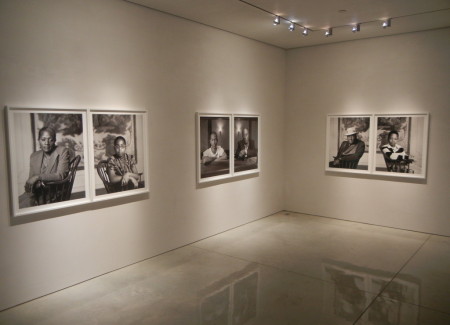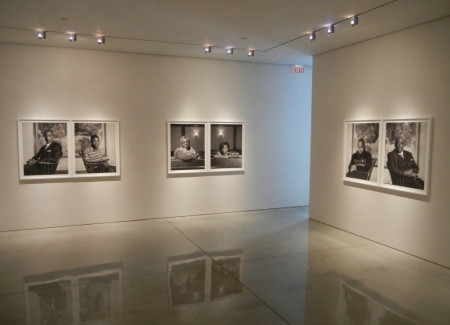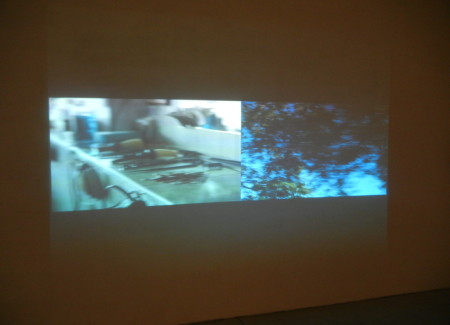JTF (just the facts): A total of 13 black and white photographic diptychs, each image framed in white and unmatted, and hung against light grey walls in the single room gallery space. All of the works are archival pigment prints mounted on Dibond, made in 2012. The diptychs are sized 40×64, and available in editions of 6+2AP. The exhibit also includes 1 video, shown in a darkened side room. It is a two channel video with sound (duration 11 minutes 23 seconds), made in 2013. It is available in an edition of 4. The works were originally commissioned by the Birmingham Museum of Art. (Installation shots below.)
Comments/Context: On September 15, 1963, four young girls were killed in the Sixteenth Street Baptist Church in Birmingham, Alabama, by a bomb put there by the Ku Klux Klan. In the violence that immediately followed the attack, two more young boys were killed. These events became a touchstone in the Civil Rights movement, not only because the incident took place in a place of worship, but particularly due to the fact that the victims were innocent children.
As part of efforts to commemorate the fiftieth anniversary of the bombing, Dawoud Bey recently returned to Birmingham and made a series of paired portraits of its current residents. His subjects were chosen with particular care and sorted into two groups: boys and girls aged between 11 and 14 (the same ages as the victims of the bombings) and men and women in their early 60s (the age the victims would be today had they lived). He then sat these folks in church pews and spare Windsor chairs, and made large black and white portraits, full of quiet, engaged dignity.
The real magic happens here when Bey pairs the portraits into diptychs – one young, one old, both of the same sex. With gestures that mirror each other with unlikely symmetry and synchronicity (folded arms, similar hairstyles, matching vests, and stern expressions), it isn’t hard to see these images as approximations of time elapsed versions of the same person. This conceptual collapsing of time gives the pictures their power, and opens up plenty of additional layers of potential meaning. What kinds of lives might the victims have led had they not been killed? How might history have been different? What do the elders see when they look back at all that has happened since?
These are understated, direct portraits that resonate with crisp, honest patience. Serious faces, both young and old, stare out with perseverance, spiced with alternating glimpses of regal confidence and world weary resignation. The fifty year gap is visually complicated; in intermingles invisible feelings of loss, memory, endurance, and promise, with physical resemblance and psychological echo. A video work in a side room slows down time even further, turning a still Sunday morning in Birmingham into a lingering poetic presence, wandering over empty barber shops and beauty parlors, and staring up with wonder at the blue sky through the dappled trees.
While Bey’s photographs have a particular and specific context in the African-American experience, the conceptual device he’s employed is in many ways universal; we could apply the same approach to children caught in the crossfire of wars, conflicts, and hate crimes throughout history and from all over the world, and we would discover a similar nuanced agony in comparing what might have been and what ultimately occurred. In this manner, Bey’s lessons from Birmingham extend much father than their normal boundaries. They chart parallels and draw similarities in more all-inclusive ways, reminding us of the individuality of the six very real individuals who died, but transforming and extending their loss into more abstract ideas that are applicable to all.
Collector’s POV: The photographic works in this show are priced between $17500 and $22500 (diptychs); the video is $7000. Bey’s work has surprisingly little secondary market history, so gallery retail likely remains the best option for those collectors interested in following up.










